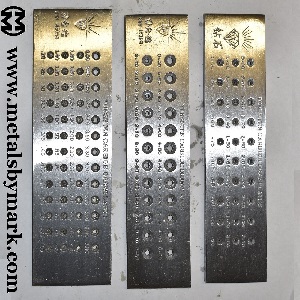
Drawplates
Round and square
Categories: Instruction and information; Jewelry
Word count/read time: 506 words; 2 minutes
No, it's not an instructional class with a spaghetti ball of jumbled wire that
hopeful artists are trying to sketch. This is about making wire in a shop setting
using non-mechanized equipment. There will be forging implements like a hammer or set of
dies, power through electricity or beast, and heat from furnace or flame.
Cooperative metals include gold, silver, copper, and their alloys.
Most metals work harden as they are being drawn or forged, making them more difficult
to shape and manipulate. The crystal or grain structure gets homogenized and increases
temper (essentially, hardness). Dead-soft is a world away from spring state, and 10k
gold is nothing like 0.999 fine silver.
Several steps will be repeated endlessly until the proper size wire is
reached. These steps are mundane and not terribly exciting so most people enjoy the
convenience of pre-made wire or ready-to-use jump rings.
Barring hyper-modern technology, everything starts as an ingot that eventually becomes a
square or round rod. The metal is annealed...maybe once, maybe
a dozen times over the duration. It becomes more malleable (able to be flattened into sheet) and ductile
(drawn or extruded into wire).
Next, it will be pulled through a drawplate which has
a series of holes with tiny increments between adjacent ones. There are round, square,
triangular, and other wire profiles available. Precision carbide inserts are mandatory for
jewelry since the other ones are basically junk.
The tip of the wire is put into the appropriate hole and the
remainder is pulled (drawn) through, reducing or changing its cross-section.
This continues in successively smaller holes until it's the proper size.
Wire must enter and exit the drawplate perfectly straight,
cleaned so debris doesn't damage it, and lubed to help it slide easily.
It has to be pulled at a constant rate, too. Some metals/wires are particular about
how much distance there is between the pliers and the drawplate; they
will vibrate and chatter. Resonant frequency or something like it will ruin the wire.
Whereas I can make wire in increments of 0.1mm or smaller, commercial selections
often jump two gauge sizes. Going from 10ga
to 12ga is a 0.53mm difference!
Titanium and stainless steel are not doable in shop so it's whatever the marketplace has.
Drawbenches or drawtables make quick work of thick wire. Making a wire
longer than the drawtable, which is usually 8ft or shorter,
requires constantly repositioning the tongs. The wire will have tong marks
wherever they grab. Those sections would have to be removed either before making the next
product or cut out afterwards. That means a lot of follow-up work or
a herd of short wires. Dealing with dozens of wirelings is a headache.
(To make 1700 jump rings with 0.5mm wire diameter and 1/2" inner diameter uses close to
250ft of wire. A four-foot drawtable would mean about 75 separate pieces, each wireling making about
30 jump rings from a coil less than 3/4" long. This is impractical as is sleuthing out the
defective jump rings if left in one continuous wire.)
Posted by M: January 24, 2019
Please email any thoughts or comments regarding this post.
Comment Section
NOTE: Your comments will be included in this section
as long as they aren't illegal. This section is censor-free so show me
your intelligence or ignorance and everything in between!
|
2026
Review: Commarker Titan 1
Pesky Descriptors
Top Purchases 2025
2025
2024
2023
2022
2021
2020
2019
2018
2017
2016
2015
2014
|